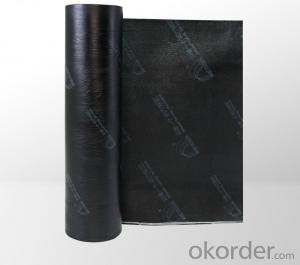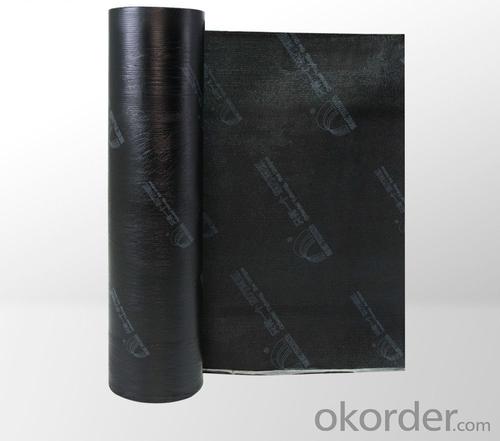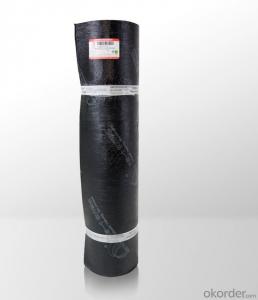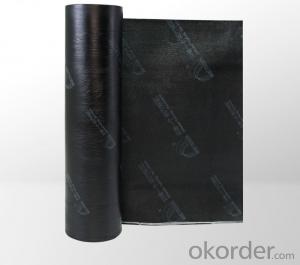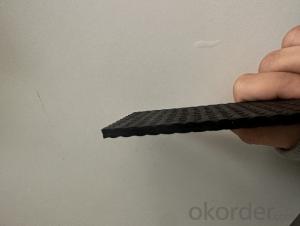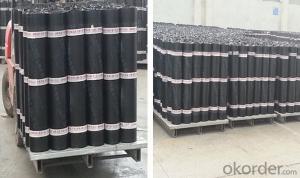PMB-742 Ultralow Temperature Elastomer (SBS) Modified Bituminous Water Proof Sheet Material
- Loading Port:
- China main port
- Payment Terms:
- TT OR LC
- Min Order Qty:
- 1000 m²
- Supply Capability:
- 500000 m²/month
OKorder Service Pledge
OKorder Financial Service
You Might Also Like
Ultralow Temperature Elastomer (SBS) Modified Bituminous Waterproof Sheet Material is a
thermoplastic and elastic modified bituminous dipping and coatingmaterial made out of Stylene-Butadiene-Stylene, it is a kind of rollable sheet water proof materials with the upper surface cover of the isolating materials like polyethylene film, fine sand or mineral slice (or particle) etc.
Type and Specification
·The physical and mechanical properties were divided in
Type Ⅰ and Type Ⅱ .
·Classified by upper surface isolating material: Polyethylene
film (PE), fine sand (S) and mineral particle (M). See below
table for detailed specifications.
Advantages
·Excellent ultralow temperature resistance performance, good
flexibility even under -40℃ , adapted to chilly region.
·The combination of filament polyester filler base and SBS
modified bitumen, forming a high strength water proof layer, to have
strong resistance agaist water pressure.
·High tensile strength, high elongation, it is adaptive to shrinkage,
deformation and fracture of base.
·Good resistance of high temperature,is able to meet the need of
various seasaons.
·High strength polyester filler base material has large thickness,
resistance of puncture, breaking, tearing and resistance of fatigue.
·Good performance of resistance to corrosion, mould and
weather.
·Good workability, we may construct by hot melt cementation
method during four seasons in the whole year, hot-joint is durable
and reliable.
Application Range
Applied in Grade Ⅰ and Grade Ⅱ water proof engineering in
various industrial and civil sections, be mostly appropriate to the
following engineering:
·Various industrial and civil construction roof and underground
water proof in chilly region.
·Indoor swimming pool and fire pool water proof of industrial and
civil construction.
·Water proof for municipal engineering such as subway, tunnel,
concrete road surface, bridge surface, sewage works and refuse
landfill etc.
·Water proof for water conservancy facilities like canal and water
pool etc .
- Q: Can waterproofing membranes be painted over?
- Yes, waterproofing membranes can be painted over. However, it is important to ensure that the paint used is compatible with the membrane material. It is recommended to consult the manufacturer's guidelines or seek professional advice to ensure proper adhesion and longevity of the paint. Additionally, the surface should be clean and dry before applying the paint to ensure optimal results. Overall, painting over a waterproofing membrane can help enhance its appearance and provide additional protection against UV rays and other environmental factors.
- Q: Does a waterproofing membrane prevent water infiltration through concrete?
- Water infiltration through concrete can be prevented by a waterproofing membrane. This type of membrane is applied to concrete surfaces to establish a barrier against water penetration. Its purpose is to be impermeable to water and to serve as a protective layer that seals the concrete surface. When installed correctly, the waterproofing membrane can successfully stop water from seeping through the concrete, safeguarding the structure against water damage and potential structural problems. Nevertheless, it is crucial to consider that the effectiveness of a waterproofing membrane relies on the quality of materials utilized, the installation procedure, and the maintenance of the membrane over time.
- Q: Does a waterproofing membrane require a primer before application?
- In order to apply a waterproofing membrane, it is necessary to use a primer. The purpose of a primer is to improve the adhesion between the membrane and the substrate, guaranteeing a strong bond. Additionally, it acts as a sealant that protects the surface, preventing any moisture or impurities from affecting the efficiency of the waterproofing system. For a reliable and enduring waterproofing solution, it is crucial to apply a primer prior to the membrane.
- Q: Is a waterproofing membrane resistant to solvents or chemical spills?
- Generally, waterproofing membranes tend to resist solvents and chemical spills. They are engineered to shield against water and other liquids, including solvents and chemicals. These membranes often consist of materials like PVC, TPO, or EPDM, which exhibit impressive resistance to different solvents and chemicals. Nevertheless, the degree of resistance can differ based on the membrane's type and composition. It is advisable to review the manufacturer's specifications and seek guidance from experts to confirm the membrane's compatibility with particular solvents or chemicals prior to installation.
- Q: What is the difference between construction non-vulcanized waterproofing membrane and vulcanized waterproofing membrane?
- The advantages of the present invention Is: 1. elongation of permanent deformation is good, after stretching the rebound rate is small, no internal stress, can be fully adapted to the external factors caused by the deformation, there is no accelerated aging after the problem, so the service life can be improved 2-3 Times more than. 2. elongation, up to 1000%. 3. Natural vulcanization of a long time, can reach more than 10 years. 4. Good resistance to low temperature performance. 5. Bonding performance is good. 6. Production costs and operating costs are lower than other existing products.
- Q: Are waterproofing membranes resistant to battery acid?
- Waterproofing membranes do not usually possess the necessary resistance against battery acid. Their main function is to create a barrier against water and moisture, and they are typically composed of materials like bitumen, rubber, or modified asphalt. Although these materials may exhibit some level of acid resistance, they are not typically engineered to endure the corrosive nature of battery acid. Battery acid, commonly sulfuric acid, can inflict substantial harm on various materials, including waterproofing membranes. If you are dealing with battery acid or find yourself in a situation where exposure to battery acid is a concern, it is advisable to employ materials specifically designed to withstand the corrosive effects of battery acid or seek professional assistance for appropriate solutions.
- Q: Are waterproofing membranes resistant to alkali exposure?
- Waterproofing membranes, as a rule, show resistance to alkali exposure. Their purpose is to create a shield against water and other damaging substances, including alkalis. These membranes are crafted from materials like rubber, bitumen, or polymer-based compounds that possess a strong resistance to alkali. This guarantees the membrane's durability and effectiveness, even when confronted with alkali-rich surroundings, such as concrete or cement surfaces. Furthermore, these membranes undergo thorough testing and are manufactured specifically to endure alkali exposure, rendering them a dependable choice for waterproofing needs in diverse industries, including construction and infrastructure.
- Q: Does a waterproofing membrane require any specific surface preparation for tile installations?
- Yes, a waterproofing membrane typically requires specific surface preparation for tile installations. The surface needs to be clean, dry, and free of any dirt, dust, or debris. It is important to remove any loose or damaged tiles, repair any cracks or imperfections, and ensure the surface is smooth and level before applying the waterproofing membrane. This preparation ensures proper adhesion and a successful tile installation.
- Q: Can a waterproofing membrane be used in saunas?
- Yes, a waterproofing membrane can be used in saunas to protect the underlying structure from moisture and prevent water damage.
- Q: Can waterproofing membranes be used on concrete pipes?
- Yes, waterproofing membranes can be used on concrete pipes. Waterproofing membranes are commonly used to prevent water penetration and protect concrete structures from moisture damage. Concrete pipes, like any other concrete structure, are susceptible to water infiltration, which can lead to deterioration and reduced lifespan. Applying a waterproofing membrane to concrete pipes can help to create a barrier against water and prevent potential issues such as leaks, cracks, and corrosion. The membrane is typically applied to the exterior of the pipe, forming a protective layer that prevents water from seeping into the concrete. This can help to extend the lifespan of the pipes and ensure their long-term durability.
Send your message to us
PMB-742 Ultralow Temperature Elastomer (SBS) Modified Bituminous Water Proof Sheet Material
- Loading Port:
- China main port
- Payment Terms:
- TT OR LC
- Min Order Qty:
- 1000 m²
- Supply Capability:
- 500000 m²/month
OKorder Service Pledge
OKorder Financial Service
Similar products
Hot products
Hot Searches
Related keywords
